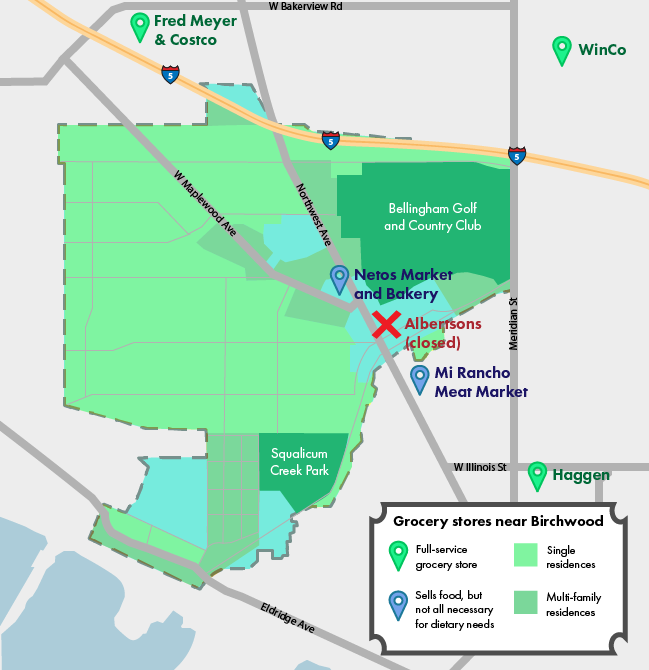Addressing Food Deserts in Whatcom County
Video by Jared Rusk, Kyra Taubel-Bruce and Daisey James
Infographics by Amy Page
Story by Kyra Taubel-Bruce
There is no solid definition for what exactly a food desert is, but a common rule of thumb is when low-income households have low access to a grocery store and healthy food options.
Food deserts cover roughly 85 percent of Whatcom County. In Bellingham’s Birchwood Neighborhood and East Whatcom County, residents have limited access to affordable fruits, vegetables, dairy and grains.
“The food system really was built up for producing larger quantities, bigger markets, volume, quantity and the little guys kind of just got forgotten to a large degree,” said Chris Elder, a co-founder of the Twin Sisters Farmers Market.
Grocery stores operate on limited profit margins. In Birchwood, Albertsons was competing with itself after purchasing Haggen and the corporation decided their profit margins would be better if they closed their doors, said Bellingham City Council Member April Barker. As a result, residents were left without a grocery store within walking distance or within a reasonable bus ride.
“For some, when [Albertsons] closed it was like ‘well there’s a Haggen a mile away,’” Barker said. “The likelihood that you’re going to walk a more than a mile or take the bus then have to walk another quarter of a mile and then carry all those groceries back is just unlikely.”
The United States Department of Agriculture defines urban households with low access to grocery are a mile or farther from a grocery store; in rural locations, this distance increases 10 miles or more.
“The likelihood that you're going to walk a more than a mile or take the bus then have to walk another quarter of a mile and then carry all those groceries back is just unlikely” April Barker, Bellingham City Council Member
People living in East Whatcom County average a 30-minute commute each day, according to a Food Landscape Report. They have access to nine convenience stores but no full-service grocery stores, according to the report.
“We really need to create a market out here to be able to sell produce,” Elder said. “Not of lot of produce goes on up the valley, but at the same time, the East County demographic maybe doesn’t eat that many vegetables because we kind of lost our connection to cooking.”


Many East County residents prefer to commute and do most of their grocery shopping in Bellingham, according to the Food Landscape Report. People have adapted their routines to take trips to town and purchase food in bulk, said Melissa Morin, a community health specialist for the Whatcom County Health Department. However, she said, this does not make consistent access to perishable produce easy.
Food access is also defined as “available and affordable” healthy food, according The Public Health Effects of Food Deserts: Workshop Summary.
People buy food that is convenient even if the food is not what they want or need, according to Mari Gallagher in The Public Health Effects of Food Deserts: Workshop Summary.
“Lack of access to fresh, healthy foods can contribute to poor diets and higher levels of obesity and other diet-related diseases,” according to the USDA. People living below the poverty line tend to have less healthy diets, according data collected by the USDA Healthy Eating Index.
At both Birchwood Elementary School and Kendall Elementary School in East Whatcom County, about 67 percent of students participate in the schools’ free and reduced lunch program, according to Office of Superintendent of Public Instruction. Looking at school demographics gives an idea for the number of children and families living in poverty, Barker said.
Efforts to improve food access and alleviate the strain of food deserts looks different from community to community. In low-income communities, food stamp or EBT access plays a key role in improving nutrition and access to healthy foods.
Solutions that work for one community don’t always work in others. In the Birdwood neighborhood, Barker said, that a lot people have a lot of ideas, but a farmer’s market or Community Supported Agriculture is not practical because of the time and effort they take.
“We have to be sensitive that [solutions are being] looked at through a very middle-class lens,” Barker said. “Many times those solutions don’t match up to either the budget or the needs of the families. So, it’s daunting, but we haven’t stopped [trying].”
